How To Move Camera Around In Blender
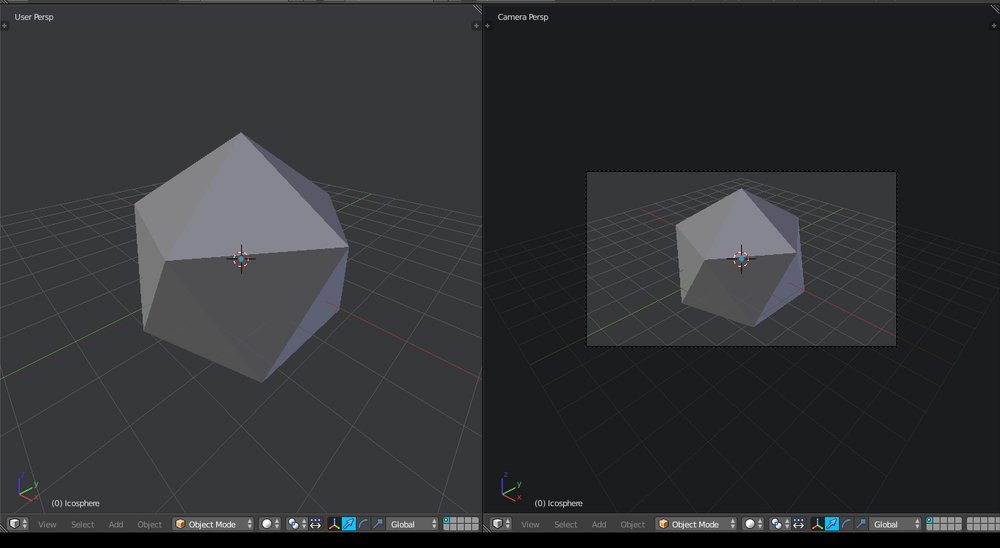
When working in Blender , you tin go confused about the difference between the viewport and a photographic camera object. It'due south understandable, since the viewport tin be idea of as a virtual photographic camera, and a camera object can be used as a viewport. Hither's what they are, and the differences betwixt them:
- The viewport is the main view that the user sees when they start Blender (see above paradigm). The viewport isn't an object; rather, it'south like a window that allows you to await around the scene that contains your model. It'due south office of the Blender interface and is only there for the development and viewing of the model. It doesn't serve any major purpose in rendering.
The photographic camera is something that must be added to the scene, or created. It'southward an object within the scene and is responsible for rendering the paradigm. Specifically, anything it's pointed at will be function of the rendered prototype. Photographic camera objects, all the same, are not designed to be moved as easily as the viewport and, therefore, are not suitable for development purposes. If you lot want to learn how to navigate your model and aren't interested in rendering an image from information technology, a photographic camera object isn't necessary.
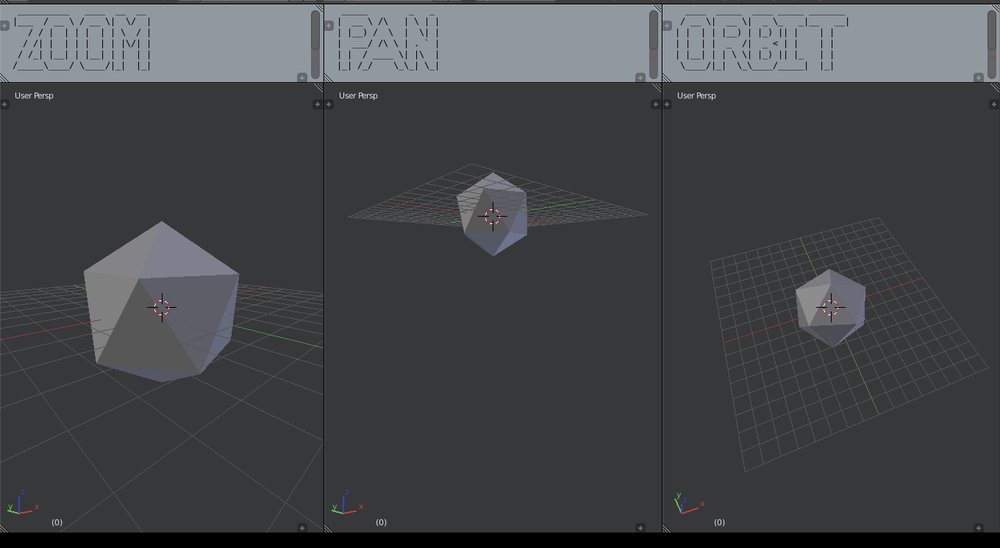
Note: This method of navigating works only with the viewport. Use a different method if y'all're looking to motility a camera. There are three principal motions that ane would apply in the viewport: zoom, orbit, and pan. Zoom moves the viewport closer or farther from the center of the scene. Orbit rotates the view effectually the eye of the scene. Pan moves the entire scene across the viewport in any direction. Here's how to do each motion:
- Zoom: Simply scroll the mouse bike up or down while the cursor is over the viewport. Alternatively, you could hold downwards Ctrl and the mouse wheel push button while moving your cursor upwardly or down on the screen.
- Orbit: Hold down the center mouse push button while moving your cursor effectually the viewport. Be sure to start holding down the middle mouse button while your cursor is within the viewport.
- Pan: Hold downwards Shift and the middle mouse button while moving your mouse across the viewport. Just like orbiting, panning requires that your cursor exist inside the viewport before yous hold down the keys.
If y'all don't take a scroll wheel or ringlet wheel push, encounter the Blender manual for instructions on emulating the curl bike, also called the third mouse button.
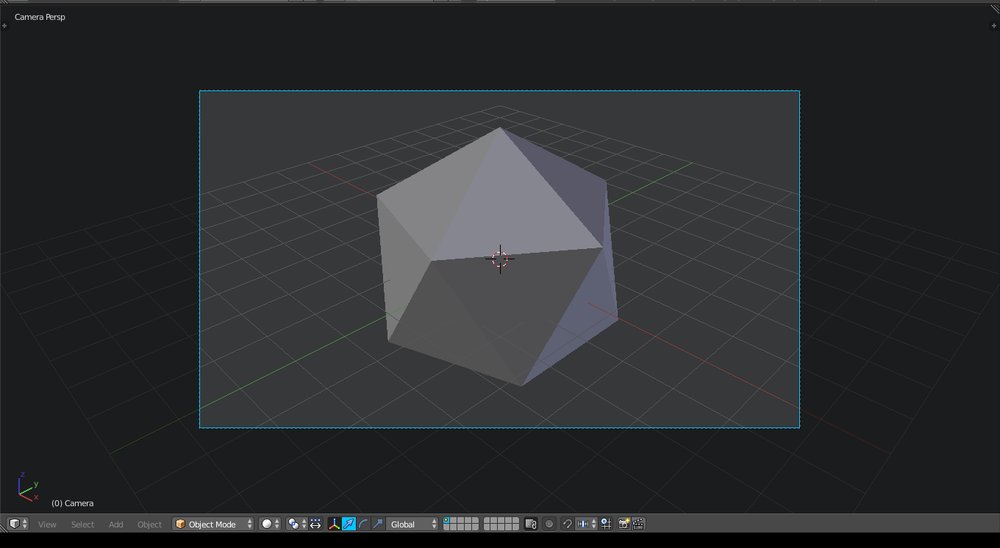
Note: Direct controls only work with a camera object, so don't try to use them for the viewport. Though not the preferred method of moving a camera, it'south still very useful.
After selecting your photographic camera past left-clicking on it, you can either translate it or rotate it. Translating is the same as panning or zooming in the previous department. In other words, you tin do both with the translate control. Rotating the camera tilts it in one direction, be it clockwise or counterclockwise, upward or downwards, left or right.
- Interpret: Printing 'M' while the camera's selected. You can now move your mouse cursor to pan the camera.
- To zoom, press Ctrl and the mouse wheel once simultaneously, and movement the mouse to zoom in or out.
- To pan, simply move the mouse around later pressing 'G'.
- If you lot only want to pan in i centrality, printing '10', 'Y', or 'Z' on your keyboard to toggle centrality locks.
- Rotate: Printing 'R' while the photographic camera's selected. Moving the mouse cursor rotates the view clockwise or counterclockwise.
- To turn the camera left or right, press 'Z' and move the mouse cursor.
These movements are easier to make while in the photographic camera view. If you want to align the camera to the current viewport view, yous tin can do so by pressing Ctrl + Alt + 0 on the number pad.
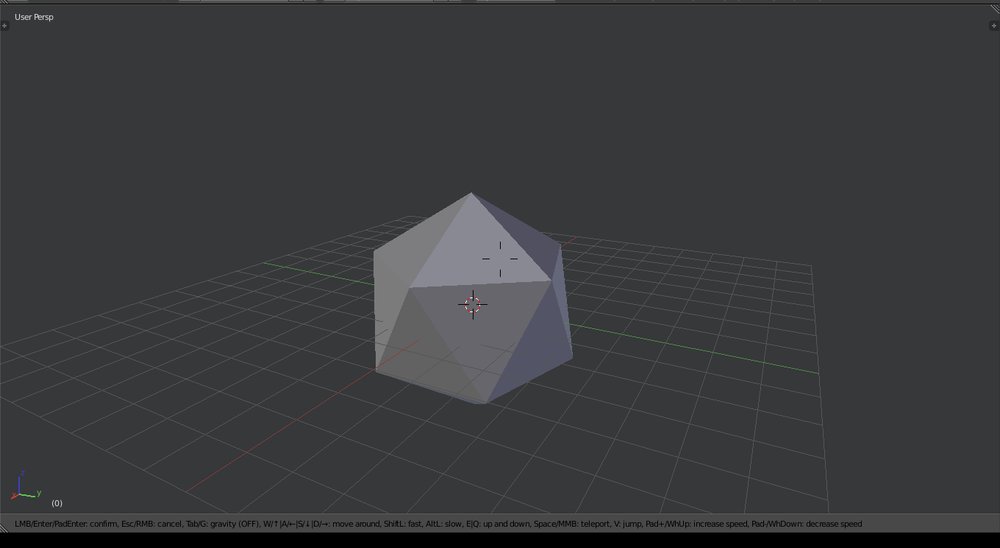
This is perhaps the easiest way to move the camera or the viewport. The get-go-person view, known as Walk Navigation in Blender , allows you to "move around" using the mouse to rotate and the keyboard to "pace" frontward, backward, side to side, upward, and down. These controls are similar to those in many video games.
Note that if you are using Blender 2.8 or later, the default shortcut to enter first-person view has changed from Shift + F to Shift + Grave key (that is, Shift + `). If you lot want to change information technology dorsum, follow these simple steps:
- Go into the preferences located on the "Edit" menu at the summit left of the screen.
- Select the "Keymap" section and on the proper noun search, blazon "Wing".
- Click the default shortcut box.
If the speed at which the view moves isn't to your liking, you can coil the mouse wheel upward to speed upward or downwards to irksome down the rate of motion. Once you lot are done looking around, or you lot accept set your view to your desired position, press enter or left-click to exit the first person view. Your current viewport or camera view will exist saved once you lot exit. It can so be moved using any of the other ii methods. Now you know how to navigate your scene in Blender, whether information technology's through a camera for a return or in the viewport so yous tin continue modeling at a new angle!
iRender is a Professional person GPU-Acceleration Cloud Rendering Service provider in HPC optimization for rendering tasks, CGI, VFX with over 20.000 customers and being appreciated in many global rankings (due east.g. CGDirector, Lumion Official, Radarrender, InspirationTuts CAD, All3DP). We are proud that we are one of the few render farms that back up all software and all versions. Users volition remotely connect to our server, install their software only one time and easily practice any intensive tasks similar using their local computers. Blender users tin easily cull their automobile configuration from recommended system requirements to high-finish options, which conform all your project demands and will speed upwardly your rendering procedure many times.
High-end hardware configuration
- Single and Multi-GPU servers: 1/two/4/6x RTX 3090/3080/2080Ti. Peculiarly, NVIDIA RTX 3090 – the most powerful graphic card.
- x/24 GB vRAM capacity, plumbing fixtures to the heaviest images and scenes. NVLink/SLI requested for bigger vRAM.
- A RAM capacity of 128/256 GB.
- Storage (NVMe SSD): 512GB/1TB.
- Intel Xeon West-2245 or AMD Ryzen Threadripper Pro 3955WX CPU with a high clock speed of 3.90GHz.
- Additionally, iRender provide NVLink (Asking) will help y'all increment the corporeality of VRAM to 48GB. This is a technology co-developed by Nvidia and IBM with the aim of expanding the data bandwidth between the GPU and CPU 5 to 12 times faster than the PCI Limited interface. These servers are certain to satisfy Blender artists/ studios with very complex and large scenes.
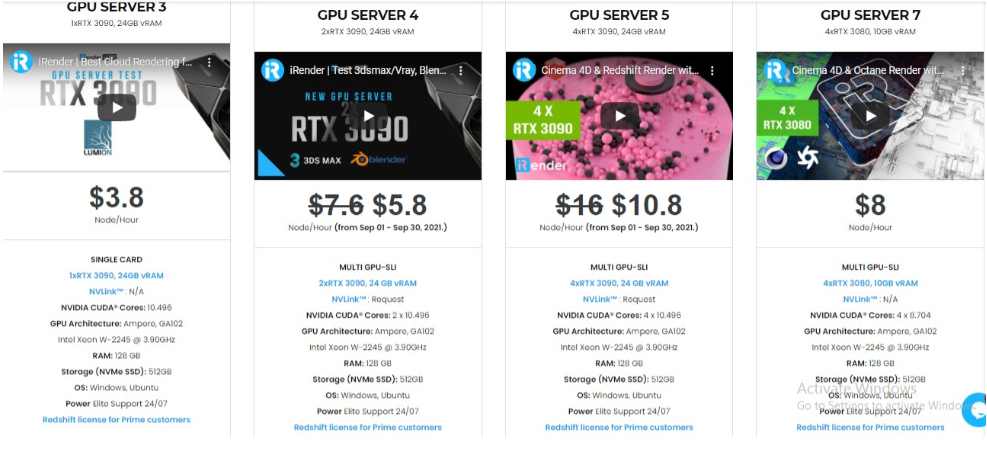
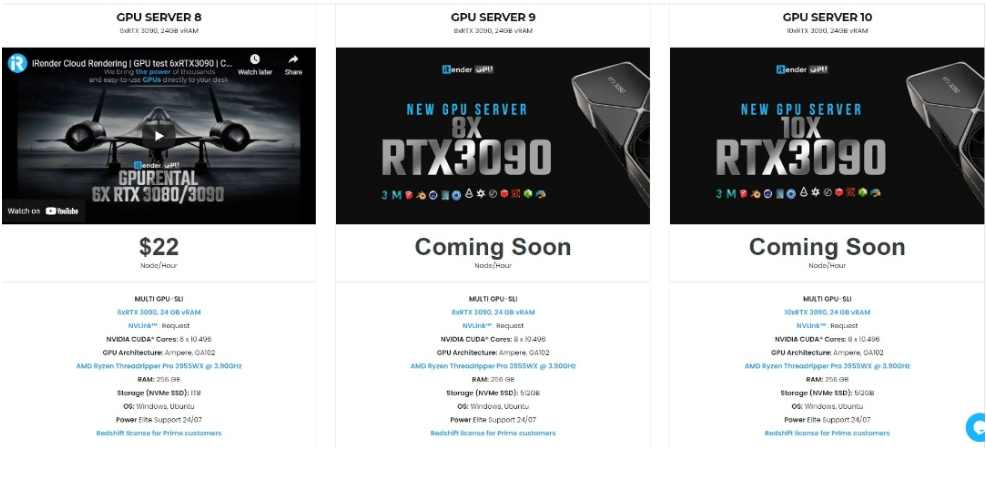
Permit'due south see rendering tests with Blender on multi-GPU at iRender:
- Reasonable cost
iRender provides high-end configuration at a reasonable price. You lot can encounter that iRender'southward parcel always costs much cheaper than packages of other render farms (in performance/cost ratio). Moreover, iRender's clients will enjoy many attractive promotions and discounts. For example, this Oct, we offer a promotion for new users and discounted prices for many servers, users will take advantage of these to level up their renders.
SPECIAL Offering for this November: Get fifty% BONUS for all newly registered users.

If you have whatsoever questions, please do not hesitate to reach u.s.a. via Whatsapp: +(84) 916017116. Register an Business relationship today and get Gratis COUPON to feel our service. Or contact us via WhatsApp: + (84) 916017116 for advice and support.
Thank you & Happy Rendering!
Source: all3dp.com
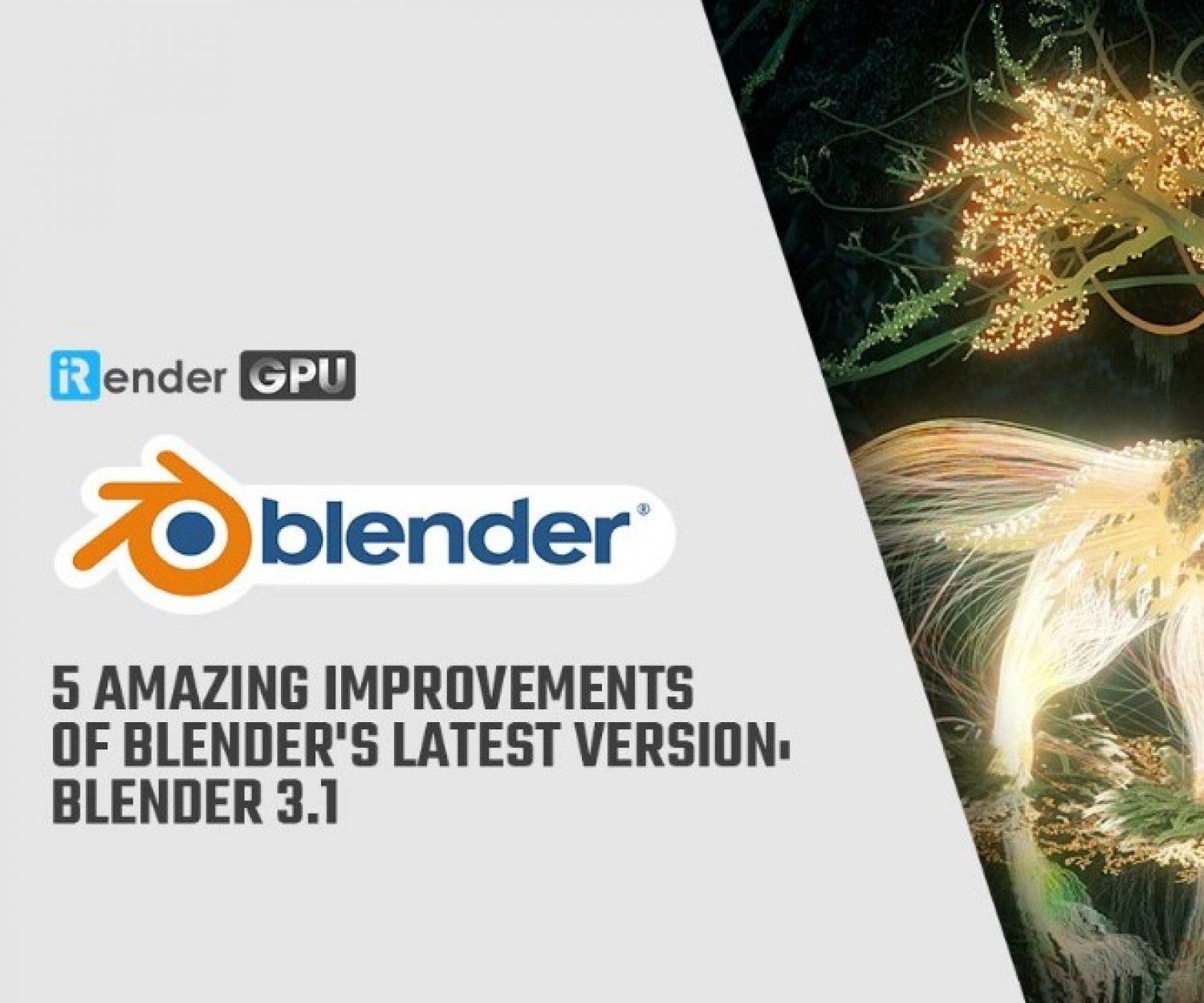
17 Mar 2022
Most recently, the Blender Foundation has shipped Blender iii.i, the latest version of this open-source 3D software. It's a functioning-focused…
Source: https://irendering.net/how-to-move-camera-in-blender/
Posted by: ellisreem1944.blogspot.com


0 Response to "How To Move Camera Around In Blender"
Post a Comment